Cell Biology+ Flashcards
Introduction to Cells
Cell Theory
- %%All living organisms are composed of one or more cells%%
- %%Cells are the smallest units of life%%
- %%All cells come from pre-existing cells%%
Atypical Cells
Striated Muscle Cell
composed of sarcomeres
each cell is multinucleated
the average muscle fibre is approximately 30 mm long (larger than a typical cell)
challenges the idea that a cell has one nucleus, as the striated muscle cell is comprised of multiple nuclei
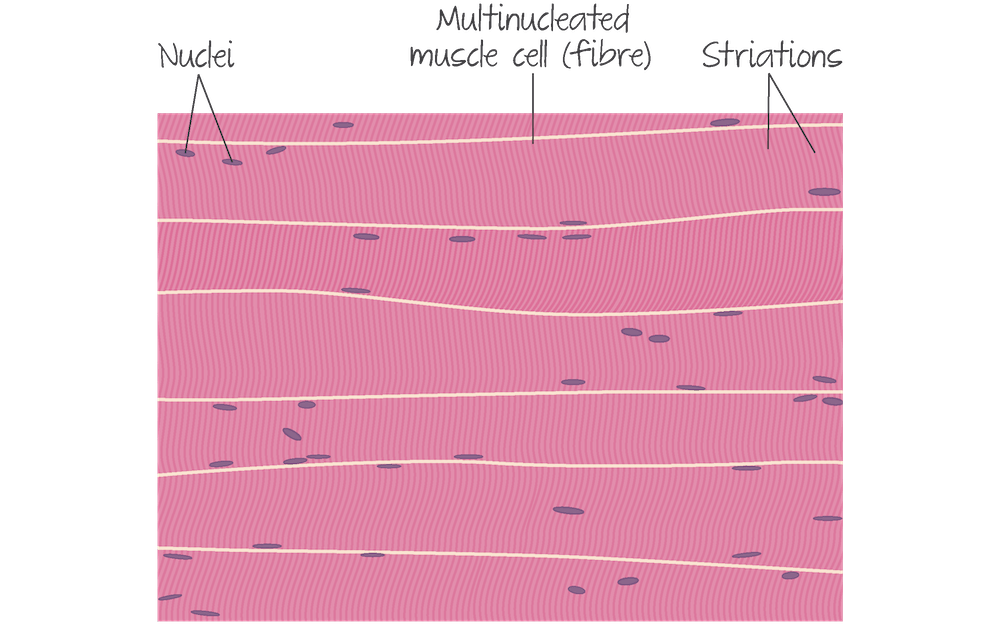
Giant Algae: Acetabularia
genus of single-celled green algae of gigantic size, ranging from 0.5 to 10 cm in length
consists of the rhizoid (looks like small roots), the stalk and a top umbrella (made of branches that may fuse into a cap).
challenges the idea that cells must be simple in structure and small in size
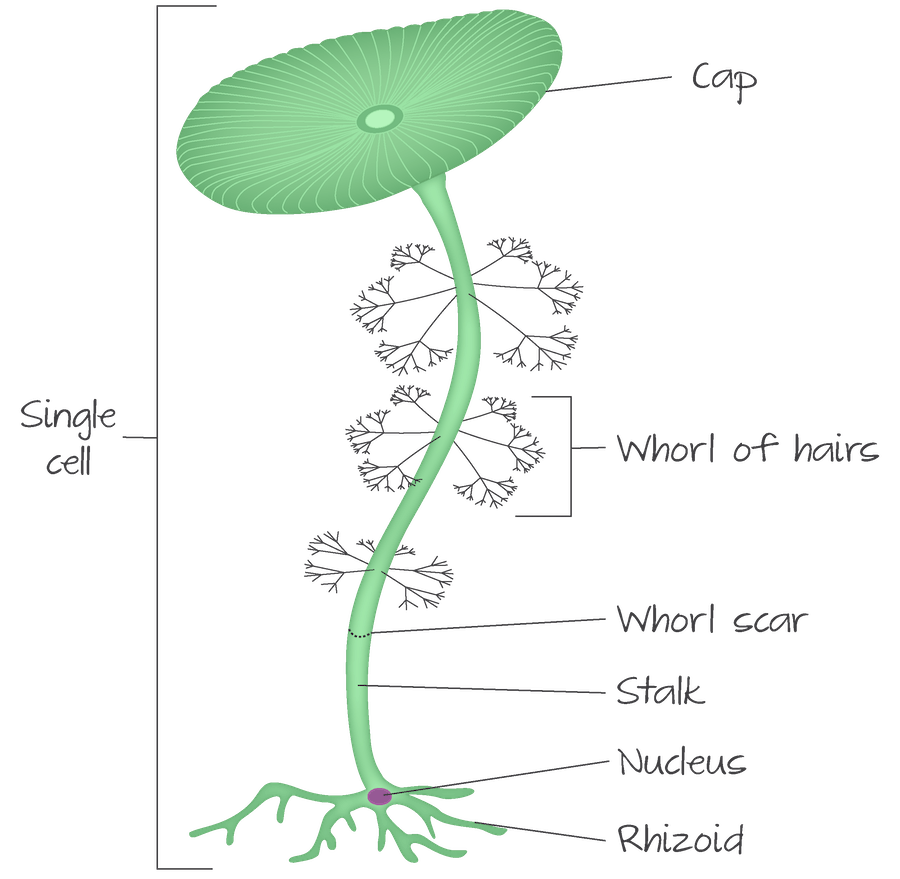
Aseptate Fungal Hyphae
they are hyphae with many nuclei
they have NO septa
the result of this is shared cytoplasm and multiple nuclei
challenges the idea that a cell is a single unit (the fungal hyphae have many nuclei, are very large and possess a continuous, shared cytoplasm
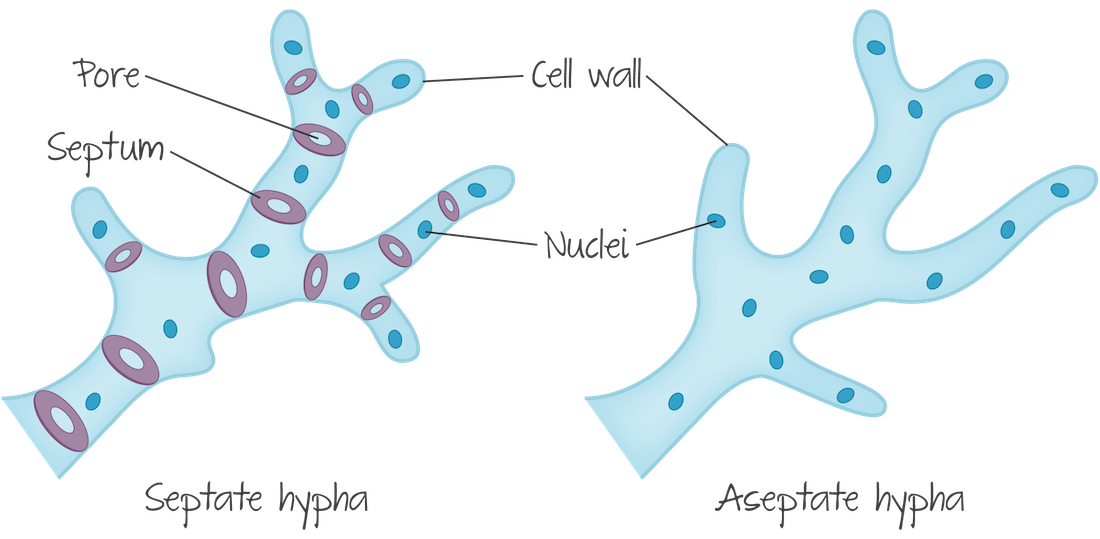
Investigating Cells and Tissues with a Microscope
- a typical cell ranges from 10 to 20 μm (micrometre) in diameter
Calculating Magnification
- Commonly used units when measuring cells or cellular parts are:
- {{1000 nm (nanometres) = 1 μm (micrometre){{
- {{1000 μm (micrometres) = 1 mm (millimetre){{
- <<magnification<< <<= size of drawing / actual size<<
- <<size of specimen<< <<= field of view (FOV) / number of specimens<<
- ensure that all measurements are given to the same units
- <<total magnification<< <<= ocular lens magnification x objective lens magnification<<
Unicellular Organisms
- {{Unicellular organisms carry out seven life functions:{{
- metabolism
- growth
- response (to a stimulus)
- homeostasis
- nutrition
- reproduction
- excretion
- homeostasis: %%the maintenance of a constant internal environment by regulating internal cell conditions.%%
- metabolism:
- %%the regular set of life-supporting chemical reactions that takes place within the cells of living organisms%%
- it is the sum of all chemical changes that take place in a cell (synthesis of new molecules + breakdown of the removal of others)
Surface Area to Volume Ratio
- %%the rate at which substances cross the cell membrane depends on their surface area%%
- as a cell grows, the volume of the cell increases by a power of 3 (cubed), whereas the surface area of the cell increases by the power of 2 (squared). As such, the surface area to volume ratio decreases as the cell gets bigger.
- as a cell increases in size, its surface area to volume ratio decreases
- a large surface area to volume ratio allows for:
- heat loss to occur faster
- a larger and faster exchange of waste materials
Specialized Structures
- villi and microvilli extend off the cell to increase surface area allowing for more efficient absorption
- folds in the plasma membrane are found in the:
- immune system
- lungs
- gastrointestinal tract
- as a cell increases in size, its small surface area to volume ratio limits the rate of exchange of materials with its surroundings. A potential solution to this problem is developing projections from the cell membrane (microvilli) to increase its surface area
Multicellular Organisms
- {{The evolutionary steps of multicellular organisms are as follows:{{
- organisms grew larger as they were no longer limited by the size of one cell
- limited by the size of one cell in such an organism were able to specialize through differentiation
- multicellular organisms displayed emergent properties
- genome: %%the complete set of genes, chromosomes or genetic material present in a cell or organism%%
- differentiation: %%when an unspecialized stem cell changes and carries out a specific function in the body. cells differentiate to form different cell types due to the expression of different genes%%
- according to emergent properties: a complex system possesses properties that its constituent parts do not have - the whole is more than the sum of its parts.
Cell Functions
- Cell Membrane
- semi-permeable membrane that protects the cell
- lets things move in and out of the cell
- location: around the cell
- Nucleus
- the control center of the cell
- location: inside the cell, near the centre
- Nucleolus
- makes ribosomes
- location: inside the nucleus
- Nuclear Membrane
- protects the nucleus
- lets thing move in and out of the nucleus (pores)
- location: around the nucleus
- Mitochondria
- produces energy (powerhouse of the cell)
- location: in the cytoplasm
- Golgi Bodies/Apparatus
- packages and secretes waste
- location: in cytoplasm
- Endoplasmic Reticulum (E.R.)
- transports materials and sends messages to all parts of the cell
- There are 2 types of ER: rough (has ribosomes) and smooth
- both have the same function
- location: attaches from cell membrane to nuclear membrane
- Ribosomes
- makes proteins
- location: in the cytoplasm or attached to the E.R.
- Vacuole
- stores food and water
- plants have one big vacuole; animals have multiple
- location: in cytoplasm
- Lysosome
- contains digestive enzymes
- destroys bacteria, old cell parts
- location: cytoplasm
Prokaryotic and Eukaryotic Cells
- Procaryotic cells existed before eukaryotic cells
- Pro=before
- eu=true
- eukaryotic cell: has a true nucleus
- prokaryotic cells: have a nucleoid region, no nucleus
Prokaryotic Cells
- one-celled organisms
- prokaryotic cells go through asexual reproduction, called %%binary fission%%
- fast, simple, requires few resources and less energy
- good for rapid survivals of conditions that are harsh
- short-term gain as a species
- Process of binary fission
- the chromosome is replicated semi-conservatively, beginning at the point of origin
- beginning with the point of origin, the two copies of DNA move to opposite ends of the cell
- the cell elongates (grows longer)
- the plasma membrane grows inward and pinches off to form two separate but genetically identical cells
- parts:
- plasma membrane
- cytoplasm
- pili
- flagella
- 70S ribosomes
- no organelles
- few internal structures
- unicellular or colonial
- cell wall
- cell membrane
- circular chromosomes
- no nuclear membrane. Has nucleoid region
- plasmids
Eukaryotic Cells
- contain organelles surrounded by membranes
- can be unicellular or multicellular
- eukaryotic cells have a compartmentalized cell structure, which refers to the formation of compartments within the cell by membrane-bound organelles.
- parts
- linear chromosomes
- plasma membrane
- cytoplasm
- mitochondria
- 80S ribosomes
- nucleus
- nucleolus
- smooth and rough ER (endoplasmic reticulum) Golgi apparatus
- vesicle
- lysosomes
- centrioles
- vacuole
- cell wall (plants and fungi)
- the cell membrane (all)
- chloroplast (only in plant cells)
Cell Membrane
- the cell membrane is made of a phospholipid bilayer
- proteins, lipids and carbohydrates (CHO) are scattered throughout two rows of phospholipid (PPL) molecules
- proteins can be transmembrane/integral or peripheral
- %%amphipathic: has both hydrophilic and hydrophobic, allowing for a natural arrangement into the bilayer.%%
Structure
hydrophilic heads face %%inside and outside of the membrane (the watery environments)%%
hydrophobic fatty acids %%face each other in the middle of the membrane%%

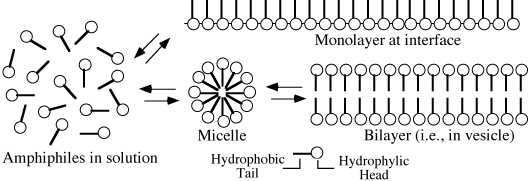
Functions of Cell Membrane
- the function of the cell membrane is to control what enters and leaves the cell (the food goes in and waste goes out); acts as a barrier between the inside and outside of the cell
- the cell membrane is semi-permeable
- small, soluble lipids can pass through
- water can pass through
- large molecules CANNOT pass through (due to how tightly packed the PPLs are)
- some molecules require energy
- %%semi-permeable: only some molecules are allowed to pass freely%%
Fluid Mosaic Model
Phospholipid Bilayer
- lipid bilayer: 2 layers of PPLs
- phosphate head is polar (water-loving)
- fatty acid tails non-polar (water-fearing)
- proteins embedded in the membrane
Membrane Proteins
- functions of membrane proteins:
- receptor sites for hormones (hormone binding sites)
- immobilize enzymes
- cell adhesion - makes tight junctions between cells
- cell-to-cell communication
- transport of materials
- passive transport
- active transport
Types of Proteins:
Integral proteins
- span across the membrane (transmembrane)
- hydrophilic parts sticking out on either side of the membrane
Peripheral proteins
- found on the inner or outer surface of the membrane
- can be attached to integral protein
Glycoproteins
- proteins with a carbohydrate (sugar) attached
- usually involved in cell recognition, signalling or sites for hormone binding
Cholesterol
- found only in animal cells
- type of lipid-steroid
- many are hydrophobic but has -OH (hydroxyl) group which makes that part of hydrophilic (to interact with (PPL heads)
- involved in controlling the fluidity of the cellular membrane
- disrupts the PPL molecules - makes the cellular membrane more fluid (not to crystallize)/ but not too fluid - rigid ring structure
- reduces the permeability of hydrophilic molecule
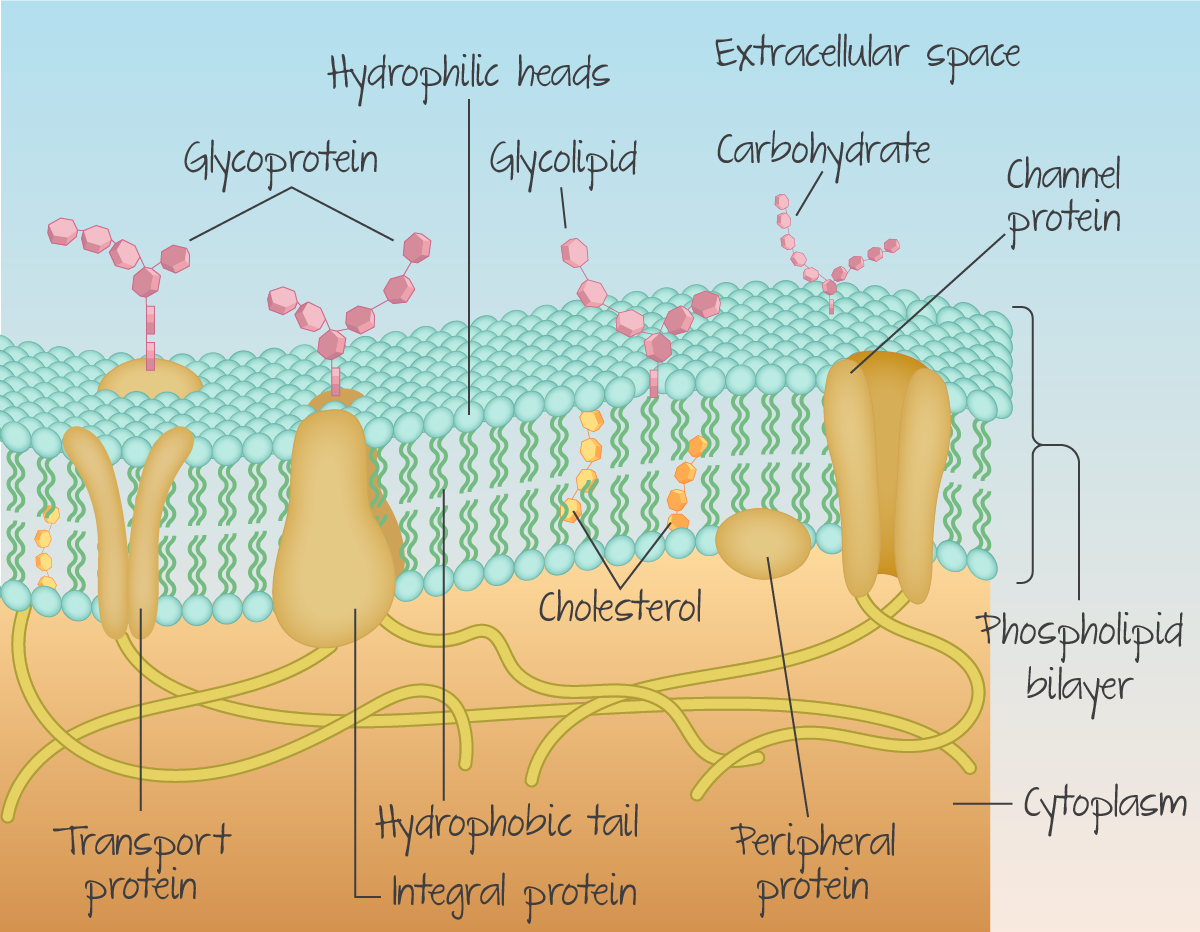
Stem Cells
- %%stem cell: an undifferentiated cell of a multicellular organism that can form more cells of the same type indefinitely, and from which certain other kinds of cells arise by differentiation%%
- properties of stem cells:
- self-renewal - the ability to divide and form new stem cells
- potency - the ability to differentiate into different cells
Types of Stem Cells
Totipotent
- %%each cell is able to develop into a new cell including extra-embryonic tissue%%
- forms to make an entire organism
- can be taken from early 1-3 days embryos
- this is called the morula, which is the first cells that are formed following the fertilization of an egg cell
- can differentiate into placental cells
Pluripotent
- c%%ells that can form any type of cell (there are 220 cell types)%%
- can be taken from the blastocyst (5 to 14 days)
- can differentiate into all body cells; not able to make an entire organism
Multipotent
- also called adult stem cells
- appear in 14-day-old embryos and beyond
- the stem cells will continue down certain lineages and cannot naturally turn back into pluripotent cells or switch lineages
- can be taken from fetal tissue, cord blood and adult stem cells.
- %%can%% %%only differentiate into some closely related types of body cells.%%
- located in the "stem cell niche"
Characteristics of Stem Cells
- unspecialized
- divide rapidly
- differentiate into several types of cells
- have a large nucleus relative to the volume of cytoplasm
- useful because they provide therapies for diseases and other health problems
Embryonic Stem Cells
- nearly unlimited growth potential
- is able to differentiate into any type of cell in the body
- higher risk of becoming tumour cells than adult stem cells
- lower chance of genetic damage due to the accumulation of mutations than with adult stem cells
- often genetically different from an adult patent that is receiving the tissue
- removing cells from an embryo kills it unless only one or two cells are taken.
Cord Blood Stem Cells
- obtained and stored easily
- commercial collection and storage services are already available
- fully compatible with the tissues of the adult that grows from the baby, so no rejection problems occur
- limited capacity to differentiate into different cell types - only naturally develop into blood cells, but research may lead to the production of other types
- limited quantities of stem cells from one baby's cord
- the umbilical cord is discarded whether or not stem cells are taken from it
Adult Stem Cells
- difficult to obtain as there are very few of them and they are buried deep in tissues
- less growth potential than embryonic stem cells
- less chance of malignant tumours developing than from embryonic stem cells
- limited capacity to differentiate into different cell types
- fully compatible with the adult's tissues, so rejection problems do not occur
- removal of stem cells does not kill the adult from which the cells are taken.
The Controversy of Stem Cells
- embryonic stem cells are derived from
- extra blastocysts that would otherwise be discarded after IVF
- the blood from the umbilical cord
- adult tissues such as bone marrow
- extracting stem cells destroys the developing blastocyst (embryo)
- can also be derived in a lab (induced pluripotent stem cells)
- Therapeutic Uses of Stem Cells
- Can be used in the treatment of leukemia and Stargardt's disease
Stages of Embryogenesis
- cleavage
- totipotent, 8-cell stage
- pluripotent, turns into a blastocyst
Cellular Transport
Types of Cell Transport
Passive Transport
- the cell does NOT use energy
- simple diffusion
- facilitated diffusion
- osmosis
- it is the movement of ions or molecules across a membrane from a region of a higher concentration to a region with a lower concentration
- Simple Diffusion:
- the random movement of particles from an area of high concentration to an area of low concentration
- continues until all molecules are even spaces (equilibrium is reached)
- note: molecules will still move around but stay spread out
- Facilitated Diffusion
- involves the transport of ions or molecules across a membrane through a membrane protein along the concentration gradient
- from highly specific channels through the membrane
- structure determines which particles can travel through
- can be open or closed in response to signals from hormones, electric charge, pressure, light
- requires channel proteins
- Osmosis
- diffusion of water through a selectively permeable membrane
- water moves from high to low concentration
- some cells have water channels called aquaporins
- this increases the permeability of water in that cell
- Hypotonic Solutions:
- fluid surrounding the cell has a LOWER solute concentration than the cell's cytoplasm
- water diffuses INTO the cell by osmosis (cell grows)
- Isotonic Solutions:
- fluid surrounding the cell has an EQUAL solute concentration as the cell's cytoplasm
- water diffuses into and out of the cell by osmosis in equal amounts (the cell does not change size)
- Hypertonic Solution:
- fluid surrounding the cell has a HIGHER solute concentration than the cell's cytoplasm
- water diffuses OUT of the cell through osmosis.
Active Transport
- the cell uses ATP directly to move molecules or ions from one side of the membrane to the other
- primary
- secondary
- involves concentration gradient
- the cell uses energy (ATP)
- actively moves molecules to where they are needed
- movement from an area of low concentration to an area of high concentration
- against the concentration gradient
Secondary Active Transport:
- uses an electrochemical gradient as a source of energy to transport ions or molecules across a cell membrane
- eg. ion pumps are carrier proteins that use ATP to pump ions across the membrane.
- e.g. sodium/potassium pumps are important in nerve responses
- concentration gradient→a difference in concentration between one side of the membrane and other
- electrochemical gradient→the combination of a concentration gradient and an electric potential (voltage) across a membrane; stores potential energy that can be used by the cell
- Sodium-potassium pump
- maintaining an electrochemical gradient between the inside and outside of the cell; the inside is negatively charged
- for every 3 sodium (Na+) ions that leaves, 2 potassium (K+) come in
- the electrochemical gradient is used by nerve cells to relay signals
Membrane-Assisted Transport
- the cell uses energy (from ATP)
- endocytosis (phagocytosis, pinocytosis), exocytosis
- this is done by vesicles
- endocytosis
- materials coming INTO the membrane
- a cell engulfs material by folding the cell membrane around it, pinching it off to form a vesicle
- e.g. antibodies from mom's milk, bacteria and viruses (immune system cells)
- phagocytosis
- cell-eating
- endocytosis involving solid particles
- pinocytosis
- cell-drinking
- endocytosis involving liquid particles
- exocytosis
- materials coming OUT of the membrane
- vesicles fuse with the cell membrane and empty their contents into the extracellular environment
- macromolecules and other large particles use this method to leave the cell
- vesicles
- a small sac of membrane
- formed by "pinching" off of the plasma membrane or membrane-bound organelles (Golgi or ER)
- moves things around the cell
Factors affecting diffusion
- molecule size
- molecule polarity
- molecule or ion charge
- temperature
- pressure
Types of membrane proteins
- channel proteins
- carrier proteins
Carrier Proteins:
- bind to specific molecules
- transport them across the membrane and release them on the other side
- changes shape
- lower rates of diffusion than channel proteins
- e.g. potassium channel in the axon (neurons)
- K+ channels are voltage-gated in axon
- when charges are more positive outside the axon, the channel is closed
- when charges are more negative outside the axon, the channel opens temporarily allowing the k+ to leave through diffusion
- in a hypotonic solution, water moves INTO the cell and the cell swells and bursts - the cell becomes turgid for plants and lysis for animals.
- in a hypertonic solution, water moves OUT of the cell, and the cell shrinks and shrivels, this is called plasmolysis in plants and crenation in animal
Origin of Cells
Miller-Urey Experiment
- simulated the conditions of early Earth's atmosphere - methane, hydrogen, ammonia gas
- used electricity to simulate lightning and storms
- Results:
- a variety of small organic molecules were produced
- e.g. amino acids (the building blocks of protein) and other carbon compounds
Conditions for Emergence of Life
- Production of carbon compounds like sugars and amino acids (simple organic molecules)
- Assembly of carbon compounds
- inorganic chemicals, such as iron sulphide, supply energy which can be used to assemble carbon compounds into polymers
- Formation of membranes
- If amphipathic carbon compounds (like PPLs) were made - they can readily form vesicles that resemble the cell membrane. this creates a separate environment (allowing chemical reactions to occur) on the inside compared to the outside
- Development of a mechanism for inheritance
- early genetic material was not DNA but RNA, which has the ability to replicate by itself and can also be a catalyst.
- since inheritance requires copying and passing genes onward and enzymatic reactions (catalyst), RNA was the best-suited molecule
Endosymbiosis
- prokaryotes most likely gave rise to archaebacteria and eubacteria
Origin of Eukaryotic Cells
- some prokaryotes lose their cell walls which allowed them to consume material through their cell membrane more easily.
- this allowed cell membranes to fold inwards and evolved into membrane-bound organelles (which explains the appearance of mitochondria and chloroplasts)
Endosymbiotic Theory
- early eukaryotic cells engulf aerobic heterotopic bacteria
- bacteria were surrounded by a cell membrane and were not digested
- they then entered a symbiotic relationship with the host cell and evolved into mitochondria
- early eukaryotic cells engulf photosynthetic bacteria and then evolved into chloroplasts
- Support for the endosymbiotic theory
- mitochondria and chloroplasts are different from other organelles as:
- they are surrounded by 2 membranes
- have their own circular DNA
- have 70s ribosomes
- replicate their own DNA and undergo division independently (binary fission) from a host cell